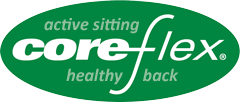A healthy sitting posture is continually changing
“The ideal sitting posture is one that continually changes, thus preventing any single tissue from accumulating too much strain.” 1
The supporting muscles of the spine tire rapidly when holding the back in a static sitting position, so a healthy posture starts with motion.Modern office chairs: the wrong kind of motion
The need for movement is well known within the seating industry, yet for 50 years the only type of postural change available in office chairs has been the backwards tilt or recline. Reclining is a way to rest more comfortably, but it is not an actual activity. Reclining is passive: it does not activate muscles and spinal structures, or stimulate the metabolism. In fact, time spent reclining in the sitting position is strongly associated with sedentary metabolic syndrome, a concentration of risk factors for diseases including type 2 diabetes, heart disease, colon and breast cancer, and obesity.2-4 This research has given rise to the expression: “sitting is the new smoking”. Clearly, the solution to sitting’s health challenges is not more reclining, but more movement!Natural human movement
In order to find the right motion for healthy sitting, we started with basic anatomy: how do humans move? Walking is the most common motion, and the large muscles of the legs and trunk are designed for constant, alternating exertion. Leg muscles aren’t meant to be sitting pads.This alternating movement of the legs, the basis of human movement, is demonstrated by newborns and even in the womb ,5 indicating that we are hardwired for this particular motion. That’s why the Core-flex technology allows the balanced alternating movement of the legs, while keeping the upper body stable.
Posture's necessary motion
Walking is not just the method for human movement; it also indicates the body's preferred strategy for dealing with gravity. In a series of studies by Drs. Marcos Duarte, Vladimir Zatsiorsky and others, subjects were asked to stand normally for up to thirty minutes on two pressure-sensing plates. What they discovered is that the body always maintains subtle side-to-side weight transfer (called postural sway) at a rate of 2 - 3 postural shifts per minute.6,7 This movement causes constant alternation of the forces on the trunk muscles that support the spine, indicating that the body prefers to avoid static postures of more than 20-30 seconds.
These conclusions tie in perfectly with Dr. McGill's advice to constantly vary sitting posture, because trying to maintain a static posture for more than several minutes will accumulate strain in the trunk muscles. The alternating movement of the Core-flex seat tilts the pelvis from side to side, providing the same alternation of force as walking, while stimulating leg and trunk muscles.
During reclined sitting, to read or watch a movie, this movement is not needed since the chair back supports the spine. But during the upright sitting of office work, the core muscles need to continually vary exertions as Prof. McGill advises, or they fatigue rapidly. Fatigued trunk muscles lead to slumped sitting, stretched lumbar ligaments, and potential damage to discs and other spinal structures.
Finally we have an answer to the #1 dilemma of sitting ergonomics: Why are the spinal support muscles exhausted so quickly during sitting? Why does everyone end up in the slouched sitting position, which has been shown to make the lower back more susceptible to pain and injury?
The Core-flex solution: your body’s preferred motion
The patented Core-flex seat encourages alternating movement in the legs and core, stimulating the muscles and giving a gentle weight shift similar to walking. Intermittent movement in the chair gives you benefits of walking without the strain of standing. For a thorough explanation of how to use and understand the Core-flex chair, please see the Healthy Sitting Guide page. For an analysis of the physiological benefits of movement while seated, please see Dr. Jenny Pynt’s article Movement and sitting: it’s all about your health.1 McGill, S M (2006). Ultimate back fitness and performance Backfitpro Inc.
2 Hamilton M T, Hamilton D G, Zderic DW (2007) Role of Low Energy Expenditure and Sitting in Obesity, Metabolic Syndrome, Type 2 Diabetes, and Cardiovascular Disease. Diabetes 56: 2655–2667.
3 Katzmarzyk P T, Church T S, Craig C L, Bouchard C (2009) Sitting time and mortality from all causes, cardiovascular disease, and cancer. Med Sci Sports Exercise 41: 998-1005.
4 Owen N, Sparling P B, Healy G N, Dunstan D W, Mathews C E (2010) Sedentary Behavior: Emerging Evidence for a New Health Risk. Mayo Clin Proc. 85: 1138-1141.
5 Ulrich B D, Jensen J L, & Thelen E. (1991). Stability and variation in the development of infant stepping: implications for control. In: Patla A. E., Editor. Adaptability of human gait. Elsevier Science Publishers
6 Duarte, M, Harvey, W, & Zatsiorsky, V M (2000). Stabilographic analysis of unconstrained standing. Ergonomics, 43(11), 1824-1839.
7 Duarte, M, Freitas, S M S F, & Zatsiorsky, V. (2011). Control of equilibrium in humans—Sway over sway. Motor control. Oxford University Press, Oxford, 219-242.




